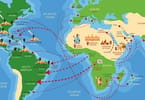The Payment Code feature, announced today, will allow PayPal users to pay for things in physical retail stores by scanning a QR code generated in the app, or by using a one-time four digit code in stores that use PIN codes but don’t have a scanner.
PayPal will introduce a new way for people to pay for goods in shops with their phones in another bid to extend its business beyond online retailers.
To use it, customers will simply have to check into a store using the PayPal app, at which point they will receive their PIN or QR code, depending on which the store uses and it will be debited in the regular way from the PayPal account. Sadly, we’ll have to wait a little longer to test it out as it’s not set to roll out until early next year. PayPal’s new mobile payments service will use QR codes and PIN numbers to verify in-store smartphone transactions over merchants’ existing point-of-sale equipment. It’s partnering with Discover, giving it a potential pool of 7 million stores.
PayPal isn’t quite done retooling its mobile app – in fact it’s saving the biggest upgrade of them all for early next year. On Wednesday the payments giant revealed at the Money2020 conference in Las Vegas that it is creating another new version of its mobile wallet that could be used to make payments in millions of stores without any significant upgrade at the check-out counter.
Called Payment Code, the technology uses the barcode scanners and PIN pads millions of retailers already have installed at their sales counters. According to PayPal head of retail Don Kingsborough, that allows PayPal to overcome two of the biggest obstacles to mobile payment adoption: getting the proper point-of-sale equipment into stores and training salespeople how to use it.
“If you don’t have technology where the consumer wants to shop, what’s the point?” Kingsborough said.
PayPal is partnering with Discover Financial Services, using its Discover Network to initiate its transactions. While that means PayPal won’t be able to tap into every store’s point-of-sale systems, it still gains an enormous potential footprint. The Discover Network is in 7 million retail locations in the U.S. alone.
To make an in-store payment, customers must first check in using the PayPal app. Once the app knows the customer’s location, it determines what kind of equipment the store has. If it has a barcode scanner, a QR code will pop up on the phone screen. The customer then simply runs that code under the scanner finalizing the transaction. If the merchant only has a PIN pad, the app will supply a randomly generated four digit PIN, which the customer then types into the terminal to verify payment.
Not only is the process simple, Kingsborough said, it’s one both consumers and salespeople are becoming readily familiar with, thanks in large part to Starbucks. The coffee chain uses a similar setup for its own mobile apps and has pretty much cornered the U.S. market for in-store smartphone payments.
PayPal is hoping to build a similar loyal following around its mobile payments by targeting retail chains where customers shop frequently, Kingsborough said. One of the reasons mobile payments have been slow to take off is because customers rarely have an opportunity to use them, he said – it’s hard to build a following around an app if a customer can only use it a handful of local stores where customers don’t shop regularly.
PayPal, however, isn’t revealing yet how it will achieve that type of scale, though it promised to deliver more details at launch. While every Discover merchant could potentially accept PayPal Code payments, every one of those 7 million U.S. locations won’t automatically start processing app-triggered transactions when the service goes live in the first quarter, Kingsborough said. Merchants will need to sign up and integrate with PayPal’s systems.
WHAT TO TAKE AWAY FROM THIS ARTICLE:
- One of the reasons mobile payments have been slow to take off is because customers rarely have an opportunity to use them, he said – it's hard to build a following around an app if a customer can only use it a handful of local stores where customers don't shop regularly.
- To use it, customers will simply have to check into a store using the PayPal app, at which point they will receive their PIN or QR code, depending on which the store uses and it will be debited in the regular way from the PayPal account.
- The Payment Code feature, announced today, will allow PayPal users to pay for things in physical retail stores by scanning a QR code generated in the app, or by using a one-time four digit code in stores that use PIN codes but don't have a scanner.

















![China's Hyperloop Train: A Glimpse into the Future of Transportation 15 Travel Tourism News | Domestic & International Hyperloop Train China [Photo: Hyperloop Transportation Technologies]](/cdn-cgi/image/width=145,height=100,fit=crop,quality=80,format=auto,onerror=redirect,metadata=none/wp-content/uploads/2024/02/180720163348-hyperlooptt-china-capsule.jpg)




